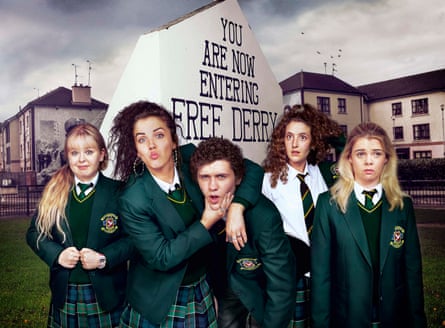They wear the same green school uniforms and speak in the same quick-fire north-west Irish accent – they are the real-life versions of the Derry Girls, the raucous, funny, eponymous heroines of the runaway hit TV drama series.
Pupils and their teachers at the school once attended by two of the young actresses in Derry Girls speak of their pride at how the programme has shown the world there is more to their city than the legacy of the Troubles and its violent backlash.
With a commanding view that stretches from the hills of Donegal across the Irish border to the river Foyle below and the city’s 17th-century walls, St Cecilia’s College is where Saoirse-Monica Jackson (who plays Erin) and Jamie Lee O’Donnell (Michelle) first trod the boards.
Current pupils at the all-girls school, whose motto is Aspire, Endeavour, Achieve, are delighted to hear that Channel 4 has commissioned a second series of Derry Girls after around 2.5 million viewers watched the very first episode.
Chloe O’Doherty, 13, said she loved the programme from the start because the writers and producers had refused to compromise on the Derry accent.
“They say things like ‘craic’, ‘ragin’, ‘aye’ and ‘hi’ and ‘like’ quite a lot. Which is the way we, like, speak to each other,” she said. “I love Derry Girls because it sounds real. There is nothing fake about it.”
Ellie May Quigley is a 17-year-old A-level student who has ambitions to produce and write. Her “hero” of the show is the feisty and witty Erin. “Erin wants to be a writer and she is an inspiration for me. She is very funny but also very determined.” Quigley was speaking just a few hours before Thursday’s final episode of the first series, in which Erin gets to edit the fictional school’s magazine.
Derry Girls is set in the early 1990s, just before the IRA and loyalist paramilitary ceasefires, when bombings, shootings and inter-community violence were part of daily life. While the real Derry girls of St Cecilia’s have lived their formative years in times of relative peace, their city is still sharply divided on sectarian lines. The Foyle marks a natural boundary, with most Protestants living on the east bank or Waterside, while Catholics are in the overwhelming majority west of the river.
Yet although the drama is based on girls from a Catholic school, and has some scenes shot beside iconic political murals in republican neighbourhoods of Derry, the St Cecilia’s pupils insisted that the script’s humour and wit-flecked one-liners appeal across the city’s traditional divide. Jordan Clarke, 14, said she had watched the series every Thursday evening at her youth club on The Diamond, a thoroughfare in the historic centre of Derry. The youth club is called Reach Across because it was set up to create a bridge between the political and geographical barriers, drawing together young people from all areas of Derry.

“My friends in the youth club who come from the Waterside love the show too. Everyone gets the comedy and the characters. The girls in the show could come from any area of the city. “
Clarke said that Derry Girls also appeals across that other, even older, social divide – gender.
“Yes, the boys in Reach Across get it too,” she said, “Some other Protestant lads in the city, not in our youth club mind, even put up a tribute to the show on Facebook, with their own banner, calling themselves Londonderry Lads.”
In her native city, even what you call home can give away your religious-ethnic identity. Most, though not all, Protestants call the city Londonderry, while to all Catholics and nationalists it will only ever be Derry. Clarke added: “The boys I meet in the youth club loved that episode where the girls adopt a young fellah whom they think is from a school from Chernobyl in the Ukraine and take pity on him, but then he turns out to be a wee loyalist Protestant kid from east Belfast who got lost in Derry and is afraid to open his mouth! Everybody everywhere gets the jokes.”
The real Derry girls of St Cecilia’s said the drama had also been an education in the Derry argot.
Scottish-born Chelsea McLaren moved with her family from St Andrews to Derry when she was just eight years old. She admitted she is still getting used to some of the specific language her Derry-born peers and the stars of the show use.
“I kept hearing the word ‘Ra’ in the series,” she said, “and kept saying to myself ‘who or what is the ‘Ra’? I didn’t know they were talking about the IRA in the programme until I asked my mates here in school about it. I’m sure it’s been an education for the people back in Scotland and in England and Wales too.”
All of the Derry Girls fan club in St Cecilia’s agreed that while the final years of the Northern Ireland Troubles provide a backdrop to the series, the drama is primarily about teenagers’ lives and the challenges of growing up, and could be set anywhere in the world.
Their principal, Martine Mulhern, can personally attest to the show’s ability to reach out across the Irish Sea and appeal to a much wider audience.
“My daughter works as a radiologist at a hospital in Cardiff and she tells me that every Friday after broadcast the night before, her colleagues are ringing her up or chatting in the canteen about how they loved the latest episode,” Mulhern said. “Despite it being set in a Troubles-era city, there are universal scenes that everyone can understand, like the argument in the chip shop over how many portions of fish’n’chips to buy on a Friday night. That sounded like Fridays in my house when my kids were little, and I think millions of other families would recognise it too.”
Greta McTague, the teacher and now head of drama who helped nurture the acting talents of two of the Derry Girls cast, said she was never surprised that Jackson or O’Donnell succeeded as actresses.
“Their success did not come overnight. They were not plucked out of nowhere by some TV talent show,” McTague said. “I remember Saoirse a few years ago, playing the Henry Miller character in a school production of Calamity Jane, and I genuinely remember saying to myself at the time: ‘That girl’s performance was outstanding.’
“Later she went on to write a scene for her drama exam about an alcoholic street drinker, a woman living on the streets of Derry, and it was very moving. Both of them put in long, long shifts, often working on the school plays on Saturdays and Sundays, so it’s hugely gratifying to see their success in Derry Girls as they were so focused and driven back then.”
McTague also paid tribute to Lisa McGee, the Derry-born writer who created the series, and who mined from her own experiences of growing up in the city to invent the colourful cast.
“I will always remember a play Lisa McGee wrote called The Heights, which was very powerful and based on an area of the Creggan [a large housing estate at the edge of the city], not very far from the school here. Lisa has been ploughing away for 10 years, so it’s fantastic that she has hit the big time with Derry Girls. No one deserves it more.”

